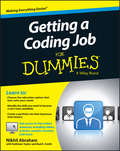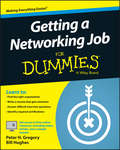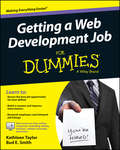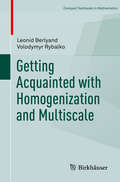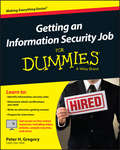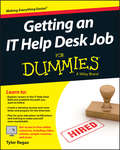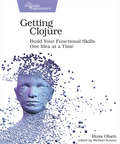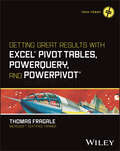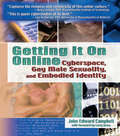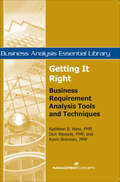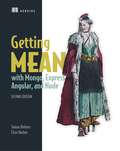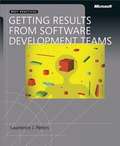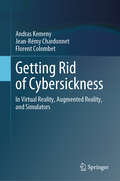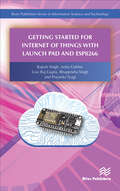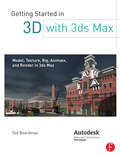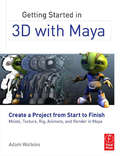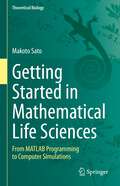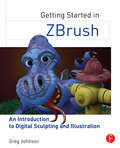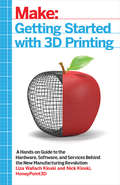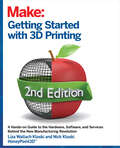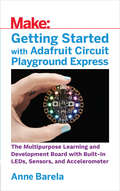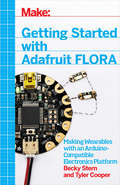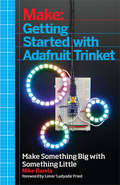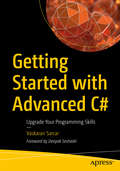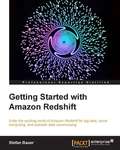- Table View
- List View
Getting a Coding Job For Dummies
by Nikhil AbrahamYour friendly guide to getting a job in coding Getting a Coding Job For Dummies explains how a coder works in (or out of) an organization, the key skills any job requires, the basics of the technologies a coding pro will encounter, and how to find formal or informal ways to build your skills. Plus, it paints a picture of the world a coder lives in, outlines how to build a resume to land a coding job, and so much more. Coding is one of the most in-demand skills in today's job market, yet there seems to be an ongoing deficit of candidates qualified to take these jobs. Getting a Coding Job For Dummies provides a road map for students, post-grads, career switchers, and anyone else interested in starting a career in coding. Inside this friendly guide, you'll find the steps needed to learn the hard and soft skills of coding--and the world of programming at large. Along the way, you'll set a clear career path based on your goals and discover the resources that can best help you build your coding skills to make you a suitable job candidate. Covers the breadth of job opportunities as a coder Includes tips on educational resources for coders and ways to build a positive reputation Shows you how to research potential employers and impress interviewers Offers access to online video, articles, and sample resume templates If you're interested in pursuing a job in coding, but don't know the best way to get there, Getting a Coding Job For Dummies is your compass!
Getting a Networking Job For Dummies
by Bill Hughes Peter H. GregoryEverything you need to start your career in computer networking Looking to land that computer networking position? Look no further! Getting a Networking Job For Dummies offers all the tools and step-by-step guidance you need to stand out from the crowd, get your foot in the door, and secure a job in this fast-growing sector. In no time, you'll get a handle on networking roles, necessary education, training, and certifications, ways to brand yourself for your dream career, and so much more. These days, computer networking can be a complicated industry, and knowing what you need to do to make yourself an attractive candidate for a coveted networking position can make all the difference. Luckily, Getting a Networking Job For Dummies arms you with everything you need to be one step ahead of the game. Humorous, practical, and packed with authoritative information, this down-to-earth guide is your go-to handbook for scoring that sought-after computer networking position! Find the right organization for you Write a winning resume that gets attention Answer difficult interview questions with confidence Identify required certifications to get the job you want If you're a prospective computer networking employee looking to present yourself as a strong, competitive candidate in the computer networking market, this hands-on guide sets you up for success.
Getting a Web Development Job For Dummies
by Kathleen Taylor Bud E. SmithCraving a career in web dev? Chart your path with this helpful guideGetting a Web Development Job For Dummies provides a roadmap to one of the "hot jobs" in the booming world of tech. The web development field is large, and it encompasses many actual functions. This book helps you understand the web development career opportunities and determine the path you should take, based on your own personal needs and preferences, to launch your career. You'll learn about various career options, the skills you'll need to become an attractive candidate, how to go about learning the ropes, and proving your abilities to a potential employer or client. With so many possible goals and no one right way to get there, this book cuts through the confusion to put you on the path to a career you want.The web development industry is expected to grow for the foreseeable future, and there is already a shortage of trained workers to fill the jobs. Whether you lean technical or aesthetic, you can find your place in the industry with right skills--both hard and soft--and with the right plan. Getting a Web Development Job For Dummies is your guide to formulating that plan and getting started right.Find formal or informal ways to build the tech skills you'll needDiscover where you fit, whether as a freelancer or within an organizationLearn how to build a resume, develop a portfolio, and impress interviewersGet expert tips on finding resources, building a reputation, and moreIf your pet peeves include malfunctioning forms, flashing banners, and sites that take way too long to load, the web development world needs you. But before you begin your journey, you need a destination and a route in mind. Getting a Web Development Job For Dummies is your roadmap, so you can set out today.
Getting Acquainted with Homogenization and Multiscale (Compact Textbooks in Mathematics)
by Leonid Berlyand Volodymyr RybalkoThe objective of this book is to navigate beginning graduate students in mathematics and engineering through a mature field of multiscale problems in homogenization theory and to provide an idea of its broad scope. An overview of a wide spectrum of homogenization techniques ranging from classical two-scale asymptotic expansions to Gamma convergence and the rapidly developing field of stochastic homogenization is presented. The mathematical proofs and definitions are supplemented with intuitive explanations and figures to make them easier to follow. A blend of mathematics and examples from materials science and engineering is designed to teach a mixed audience of mathematical and non-mathematical students.
Getting an Information Security Job For Dummies
by Peter H. GregoryGet prepared for your Information Security job search! Do you want to equip yourself with the knowledge necessary to succeed in the Information Security job market? If so, you've come to the right place. Packed with the latest and most effective strategies for landing a lucrative job in this popular and quickly-growing field, Getting an Information Security Job For Dummies provides no-nonsense guidance on everything you need to get ahead of the competition and launch yourself into your dream job as an Information Security (IS) guru. Inside, you'll discover the fascinating history, projected future, and current applications/issues in the IS field. Next, you'll get up to speed on the general educational concepts you'll be exposed to while earning your analyst certification and the technical requirements for obtaining an IS position. Finally, learn how to set yourself up for job hunting success with trusted and supportive guidance on creating a winning resume, gaining attention with your cover letter, following up after an initial interview, and much more. Covers the certifications needed for various jobs in the Information Security field Offers guidance on writing an attention-getting resume Provides access to helpful videos, along with other online bonus materials Offers advice on branding yourself and securing your future in Information Security If you're a student, recent graduate, or professional looking to break into the field of Information Security, this hands-on, friendly guide has you covered.
Getting an IT Help Desk Job For Dummies
by Tyler RegasStand out in one of IT's fastest growing job markets If you're looking for a job in IT, the help desk is the heart and soul of most IT operations, and an excellent starting point for a promising career. With the help of Getting an IT Help Desk Job For Dummies, you'll gain the knowledge and know-how to cut through the confusion of navigating the Information Technology job market. IT can be intimidating to hopeful-yet-inexperienced job candidates, but this guide will help you find and land the job of your dreams. Through easy-to-follow explanations, authoritative information, and a bit of humor, Getting an IT Help Desk Job For Dummies serves as your thorough and approachable guide to maximizing your competitive edge in this booming market. The IT job market has continued to expand as technology matures and deepens its roots in business operations. This is good news for you! However, it makes it that much harder to get a job in IT, as recent grads and other professionals are practically stampeding to get their feet in the door of this rapidly expanding industry. Luckily, Getting an IT Help Desk Job For Dummies gives you an advantage by providing expert instruction on how to score an interview and secure a job offer, the skills needed to obtain and maintain an IT position, and authoritative information on how to establish a career path in the IT field. Explore careers in the IT Help Desk field and establish the path you want to follow Plan for post-education certifications and training to make yourself more marketable Get expert guidance for creating a winning resume and cover letter Prepare for your IT Help Desk interview Loaded with simple, straight-forward advice, Getting an IT Help Desk Job For Dummies is your all-in-one guide to starting your IT career on the right foot!
Getting Clojure: Build Your Functional Skills One Idea at a Time
by Russ OlsenBehind every programming language lies a vision of how programs should be built. The vision behind Clojure is of a radically simple language framework holding together a sophisticated collection of programming features. Learning Clojure involves much more than just learning the mechanics of the language. To really get Clojure you need to understand the ideas underlying this structure of framework and features. You need this book: an accessible introduction to Clojure that focuses on the ideas behind the language as well as the practical details of writing code. Clojure attracts developers on the cutting edge and is arguably the best language for learning to program in the functional style without compromise. But this comes with a steep learning curve. Getting Clojure directly addresses this by teaching you how to think functionally as it teaches you the language. You'll learn about Clojure's powerful data structures and high-level functions, but you'll also learn what it means for a language to be functional, and how to think in Clojure's functional way.Each chapter of Getting Clojure takes a feature or two or three from the language, explains the syntax and the mechanics behind that feature so that you can make it work before digging into the deeper questions: What is the thinking behind the feature? And how does it fit in with the rest of the language? In Getting Clojure you'll learn Clojure's very simple syntax, but you'll also learn why that syntax is integral the way the language is constructed. You'll discover that most data structures in Clojure are immutable, but also why that leads to more reliable programs. And you'll see how easy it is to write Clojure functions and also how you can use those functions to build complex and capable systems.With real-world examples of how working Clojure programmers use the language, Getting Clojure will help you see the challenges of programming through the eye of experienced Clojure developers.What You Need:You will need to some background in programming. To follow along with the examples in the book, you will need Java 6 or new, Clojure 1.8 or 1.9, and Leiningen 2.
Getting Great Results with Excel Pivot Tables, PowerQuery and PowerPivot (Tech Today)
by Thomas FragaleGet more out of your data with step-by-step tutorials for the Excel features you need to know Excel is still the most popular tool for organizing and analyzing data, and today's professionals are expected to have a high degree of fluency with it. Complex Excel tools like Pivot Tables, PowerQuery, and PowerPivot can help you manage and report on data the way you need to. Getting Great Results with Excel Pivot Tables, PowerQuery and PowerPivot offers a fresh look at how these tools can help you. Author and Microsoft Certified Trainer Thomas Fragale breaks down the topics into easy-to-use steps and screenshots, so you'll be able to put your advanced Excel skills into practice right away. Using Pivot Tables, PowerQuery, and PowerPivot, you can import, sort, transform, summarize, and present your data, all without having to be a programmer. This book takes the technical jargon out of using these features, so you can do your job more efficiently, bring value to your teams, and advance your career. The plain-English instructions inside will help anyone learn to get quick, meaningful results from your data, without having a degree in computing. Get easy-to-understand walkthroughs for analyzing data and creating dashboards in Microsoft Excel Learn how to organize data in Excel and use advanced features to find patterns and insights Summarize any kind of data faster and easier, leaving you more time for other tasks Turn raw numbers into new knowledge, reports, and charts that tell coworkers and customers what they need to know This book is great for anybody who has tons of raw data and needs to make sense of it. Managers, salespeople, finance professionals, marketers—along with anyone else who works with large amounts of data—will love this quick and easy guide to Pivot Tables, PowerQuery, and PowerPivot.
Getting It On Online: Cyberspace, Gay Male Sexuality, and Embodied Identity
by John Edward CampbellLearn how gay men use Internet technologies to connect with others sharing their erotic desires and to forge affirming communities online! Getting It On Online: Cyberspace, Gay Male Sexuality, and Embodied Identity examines the online embodied experiences of gay men. At once scholarly and sensual, this unique book is the result of a three-year ethnographic study chronicling the activities on three distinct social scenes in the world of Internet Relay Chat (IRC)-virtual spaces constructed by gay men for the erotic exploration of the male body. Examining the vital role the body plays in defining these online spaces offers insight into how gay men negotiate their identities through emerging communication technologies. The author combines a critical look at the role of the body in cyberspace with candid accounts of his own online experiences to challenge conventional views on sex, sexuality, and embodied identity. Getting It On Online provides an inside look at three specific online communities-gaychub (a community celebrating male obesity), gaymuscle (a community formulated around images of the muscular male body), and gaymusclebears (a space representing the erotic convergence of the obese and muscular male bodies emerging out of the gay male "bear" subculture)-in an effort to unsettle those models of beauty and the erotic depicted in more mainstream media. The book demonstrates how the social position of these men in the physical world in regards to age, race, gender, class, and physical beauty influences their online experiences. Far from a realm of bodiless exultation, Getting It On Online illustrates how the flesh remains very much present in cyberspace. Getting It On Online examines topics such as: why people chat online the history of IRC (Internet Relay Chat) how people construct their identities in cyberspace how some online spaces function like virtual gay bars the concept of online disembodiment the role the body plays in online social relations the future of online communication ethnographic research in cyberspace mediated images of the male body and the gay male beauty myth and much more! Getting It On Online: Cyberspace, Gay Male Sexuality, and Embodied Identity is an essential resource for anthropologists, sociologists, and psychologists; academics working in gender studies, queer theory, cultural studies, and cyber-culture studies; and anyone interested in gay and lesbian issues and/or cyberspace.
Getting It Right: Business Requirement Analysis Tools and Techniques
by Kevin Brennan Don Wessels Kathleen B HassVolume of the Business Analysis Essential Library SeriesGetting It Right: Business Requirement Analysis Tools and Techniques, presents principles and practices for effective requirements analysis and specification, and a broad overview of the requirements analysis and specification processes. This critical reference is designed to help the business analyst decide which requirement artifacts should be produced to adequately analyze requirements. Examine the complete spectrum of business requirement analysis from preparation through documentation. Learn the steps in the analysis and specification process, as well as, how to choose the right requirements analysis techniques for your project.
Getting MEAN with Mongo, Express, Angular, and Node
by Simon Holmes clive harberSummaryGetting MEAN, Second Edition teaches you how to develop full-stack web applications using the MEAN stack. This edition was completely revised and updated to cover MongoDB 4, Express 4, Angular 7, Node 11, and the latest mainstream release of JavaScript ES2015.Purchase of the print book includes a free eBook in PDF, Kindle, and ePub formats from Manning Publications.About the TechnologyJuggling languages mid-application can radically slow down a full-stack web project. The MEAN stack—MongoDB, Express, Angular, and Node—uses JavaScript end to end, maximizing developer productivity and minimizing context switching. And you'll love the results! MEAN apps are fast, powerful, and beautiful.About the BookGetting MEAN, Second Edition teaches you how to develop full-stack web applications using the MEAN stack. Practical from the very beginning, the book helps you create a static site in Express and Node. Expanding on that solid foundation, you'll integrate a MongoDB database, build an API, and add an authentication system. Along the way, you'll get countless pro tips for building dynamic and responsive data-driven web applications! What's insideMongoDB 4, Express 4, Angular 7, and Node.js 11MEAN stack architectureMobile-ready web appsBest practices for efficiency and reusabilityAbout the ReaderReaders should be comfortable with standard web application designs and ES2015-style JavaScript.About the AuthorSimon Holmes and Clive Harber are full-stack developers with decades of experience in JavaScript and other leading-edge web technologies.Table of ContentsPART 1 - SETTING THE BASELINEIntroducing full-stack developmentDesigning a MEAN stack architecturePART 2 - BUILDING A NODE WEB APPLICATIONCreating and setting up a MEAN projectBuilding a static site with Node and ExpressBuilding a data model with MongoDB and MongooseWriting a REST API: Exposing the MongoDB database to the applicationConsuming a REST API: Using an API from inside ExpressPART 3 - ADDING A DYNAMIC FRONT END WITH ANGULARCreating an Angular application with TypeScriptBuilding a single-page application with Angular: FoundationsBuilding a single-page application with Angular: The next levelPART 4 - MANAGING AUTHENTICATION AND USER SESSIONSAuthenticating users, managing sessions, and securing APIsUsing an authentication API in Angular applications
Getting Results from Software Development Teams
by Lawrence J. PetersLearn best practices for software development project management--and lead your teams and projects to success. Dr. Lawrence Peters is an industry-recognized expert with decades of experience conducting research and leading real-world software projects. Beyond getting the best developers, equipment, budget, and timeline possible--Peters concludes that no factor is more critical to project success than the manager's role. Drawing on proven practices from allied industries such as business, psychology, accounting, and law, he describes a broader project-management methodology--with principles that software managers can readily adapt to help increase their own effectiveness and the productivity of their teams. Unlike other books on the topic, this book focuses squarely on the manager--and shows how to get results without adopting philosophies from Genghis Khan or Machiavelli. (There is mention of Godzilla, however.) Packed with real-world examples and pragmatic advice, this book shows any software development manager--new or experienced--how to lead teams in delivering the right results for their business.
Getting Rid of Cybersickness: In Virtual Reality, Augmented Reality, and Simulators
by Andras Kemeny Jean-Rémy Chardonnet Florent ColombetThis book provides a concise overview of VR systems and their cybersickness effects, giving a description of possible reasons and existing solutions to reduce or avoid them. Moreover, the book explores the impact that understanding how efficiently our brains are producing a coherent and rich representation of the perceived outside world would have on helping VR technics to be more efficient and friendly to use.Getting Rid of Cybersickness will help readers to understand the underlying technics and social stakes involved, from engineering design to autonomous vehicle motion sickness to video games, with the hope of providing an insight of VR sickness induced by the emerging immersive technologies. This book will therefore be of interest to academics, researchers and designers within the field of VR, as well as industrial users of VR and driving simulators.
Getting Started for Internet of Things with Launch Pad and ESP8266
by Rajesh Singh Anita Gehlot Lovi Raj Gupta Bhupendra Singh Priyanka TyagiGetting Started for Internet of Things with Launch Pad and ESP8266 provides a platform to get started with the Ti launch pad and IoT modules for Internet of Things applications. The book provides the basic knowledge of Ti launch Pad and ESP8266 based customized modules with their interfacing, along with the programming.The book discusses the application of Internet of Things in different areas. Several examples for rapid prototyping are included, this to make the readers understand the concept of IoT.The book comprises of twenty-seven chapters, which are divided into four sections and which focus on the design of various independent prototypes. Section-A gives a brief introduction to Ti launch pad (MSP430) and Internet of Things platforms like GPRS, NodeMCU and NuttyFi (ESP8266 customized board), and it shows steps to program these boards. Examples on how to interface these boards with display units, analog sensors, digital sensors and actuators are also included, this to make reader comfortable with the platforms. Section-B discusses the communication modes to relay the data like serial out, PWM and I2C. Section-C explores the IoT data loggers and shows certain steps to design and interact with the servers. Section-D includes few IoT based case studies in various fields. This book is based on the practical experience of the authors while undergoing projects with students and partners from various industries.
Getting Started in 3D with 3ds Max: Model, Texture, Rig, Animate, and Render in 3ds Max
by Ted BoardmanLearning a 3D visualization software is a daunting task under any circumstances and while it may be easy to find online tutorials that tell you what to do to perform certain tasks you'll seldom learn "why" you are performing the steps. This book approaches training from a top-down perspective way you will first learn important concepts of 3D visualization and functionality of 3ds Max before moving into the finer detail of the command structure. By learning how things work and why you might choose one method over another the book will not only teach you where the buttons are, but more importantly how to think about the holistic process of 3D design so that you can then apply the lessons to your own needs. The goal of the learning presented here is to familiarize the new user of 3ds Max with a typical workflow from a production environment from planning to modeling, materials, and lighting, and then applying special effects and compositing techniques for a finished product.
Getting Started in 3D with Maya: Create a Project from Start to Finish—Model, Texture, Rig, Animate, and Render in Maya
by Adam WatkinsDeliver professional-level 3D content in no time with this comprehensive guide to 3D animation with Maya. With over 12 years of training experience, plus several award winning students under his belt, author Adam Watkins is the ideal mentor to get you up to speed with 3D in Maya. Using a structured and pragmatic approach Getting Started in 3D with Maya begins with basic theory of fundamental techniques, then builds on this knowledge using practical examples and projects to put your new skills to the test. Prepared so that you can learn in an organic fashion, each chapter builds on the knowledge gained in the previous chapter, showing you all the essentials of 3D in Maya, from modeling and UV layout, to texture creation, rigging animating and rendering. As you go from project to project you'll develop a strong arsenal of skills that combined will form a complete end to end process to creating complete projects in Maya. The accompanying website provides all the tools you need to develop your skills. Project files to accompany the practical examples used throughout the text, so you can work along with the examples. Additional textures and models will give you all the resources you need to start making your own projects in no time at all.
Getting Started in Mathematical Life Sciences: From MATLAB Programming to Computer Simulations (Theoretical Biology)
by Makoto SatoThis book helps the reader make use of the mathematical models of biological phenomena starting from the basics of programming and computer simulation. Computer simulations based on a mathematical model enable us to find a novel biological mechanism and predict an unknown biological phenomenon. Mathematical biology could further expand the progress of modern life sciences. Although many biologists are interested in mathematical biology, they do not have experience in mathematics and computer science. An educational course that combines biology, mathematics, and computer science is very rare to date. Published books for mathematical biology usually explain the theories of established mathematical models, but they do not provide a practical explanation for how to solve the differential equations included in the models, or to establish such a model that fits with a phenomenon of interest. MATLAB is an ideal programming platform for the beginners of computer science. This book starts from the very basics about how to write a programming code for MATLAB (or Octave), explains how to solve ordinary and partial differential equations, and how to apply mathematical models to various biological phenomena such as diabetes, infectious diseases, and heartbeats. Some of them are original models, newly developed for this book. Because MATLAB codes are embedded and explained throughout the book, it will be easy to catch up with the text. In the final chapter, the book focuses on the mathematical model of the proneural wave, a phenomenon that guarantees the sequential differentiation of neurons in the brain. This model was published as a paper from the author’s lab (Sato et al., PNAS 113, E5153, 2016), and was intensively explained in the book chapter “Notch Signaling in Embryology and Cancer”, published by Springer in 2020. This book provides the reader who has a biological background with invaluable opportunities to learn and practice mathematical biology.
Getting Started in ZBrush: An Introduction to Digital Sculpting and Illustration
by Greg JohnsonGetting Started in ZBrush is a gentle introduction to ZBrush, today’s premier digital sculpting program. Beginning with the fundamentals of digital sculpting as well as a thorough introduction to the user interface, Getting Started in ZBrush will have you creating a variety of professional-level 3D models in no-time. More than just another button-pushing manual, this comprehensive guide is packed with start-to-finish projects that ease you into the workflow of the program, while at the same time providing tips and tricks that will allow you to achieve certain tasks much more quickly. After progressing through the tutorials, you will be shown how to customize brushes, materials, scripts, and the interface so that you can utilize these tools to their full advantage. Special consideration is given to ZBrush’s integration plug-ins with Maya and 3ds Max, allowing you to properly import and export your models in all programs. Texturing, painting, mapping, decimation, baking, and topology are also fully covered so your Zbrush creations can come to life without sacrificing that high-resolution look. Ease your way into this complex subject with this straight-forward approach to ZBrush Perfect your technique with step-by-step tutorials that allow you to create high res models from start to finish. Expand your knowledge by visiting the companion website, which features video demonstrations, project files, texture and model files, scripts, customized menus, brushes, and additional resources.
Getting Started with 3D Printing: A Hands-on Guide to the Hardware, Software, and Services Behind the New Manufacturing Revolution
by Liza Wallach Kloski Nick KloskiMake: Getting Started with 3D Printing is a practical, informative, and inspiring book that guides readers step-by-step through understanding how this new technology will empower them to take full advantage of all it has to offer. The book includes fundamental topics such as a short history of 3D printing, the best hardware and software choices for consumers, hands-on tutorial exercises the reader can practice for free at home, and how to apply 3D printing in the readers' life and profession. For every maker or would-be maker who is interested, or is confused, or who wants to get started in 3D printing today, this book offers methodical information that can be read, digested, and put into practice immediately!
Getting Started with 3D Printing
by Liza Wallach Kloski Nick KloskiThe book is written in a casual, conversational style. It is easily accessible to those who have no prior knowledge in 3D printing, yet the book's message is solidly practical, technically accurate, and consumer-relevant. The chapters include contemporary, real-life learning exercises and insights for how to buy, use and maintain 3D printers. It also covers free 3D modeling software, as well as 3D printing services for those who don't want to immediately invest in the purchase of a 3D printer. Particular focus is placed on free and paid resources, the various choices available in 3D printing, and tutorials and troubleshooting guides.
Getting Started with Adafruit Circuit Playground Express: The Multipurpose Learning and Development Board with Built-In LEDs, Sensors, and Accelerometer.
by Mike BarelaFrom Adafruit Industries, a leader in products to Makers, designers, students young and old, comes the Circuit Playground Express. Connect it to your PC/Mac/Linux device, and you can be programming interactive projects in minutes. You have a choice of programming environments to choose from: Python, the Microsoft MakeCode graphical building block environment, C/C++ via the Arduino development environment and JavaScript.ment their ideas.
Getting Started with Adafruit FLORA
by Tyler Cooper Becky SternThis book introduces readers to building wearable electronics projects using Adafruit's tiny FLORA board: at 4.4 grams, and only 1.75 inches in diameter, and featuring Arduino compatibility, it's the most beginner-friendly way to create wearable projects. This book shows you how to plan your wearable circuits, sew with electronics, and write programs that run on the FLORA to control the electronics. The FLORA family includes an assortment of sensors, as well as RGB LEDs that let you add lighting to your wearable projects.
Getting Started with Adafruit Trinket
by Mike BarelaArduino's ubiquity and simplicity has led to a gigantic surge in the use of microcontrollers to build programmable electronics project. Despite the low cost of Arduino, you're still committing about $30 worth of hardware every time you build a project that has an Arduino inside. This is where Adafruit's Trinket comes in. Arduino-compatible, one-third the price, and low-power, the Trinket lets you make inexpensive and powerful programmable electronic projects. Written by one of the authors of Adafruit's Trinket documentation, Getting Started with Trinket gets you up and running quickly with this board, and gives you some great projects to inspire your own creations.
Getting Started with Advanced C#: Upgrade Your Programming Skills
by Vaskaran SarcarUnderstand and work with the most important features of advanced C# in different programming environments. This book teaches you the fundamental features of advanced C# and how to incorporate them in different programming techniques using Visual Studio 2019.The book is divided into two parts. Part I covers the fundamentals and essentials of advanced programming in C#. You will be introduced to delegates and events and then move on to lambda expressions. Part II teaches you how to implement these features in different programming techniques, starting with generic programming. After that, you will learn about thread programming and asynchronous programming, to benefit from a multi-threaded environment. Finally, you will learn database programming using ADO.NET to connect to a MySQL database and you will know how to exercise SQL statements and stored procedures through your C# applications.What You Will Learn Use delegates, events, and lambda expressions in advanced programmingMake your application flexible by utilizing genericsCreate a fast application with multi-threading and asynchronous programmingWork in Visual Studio Community Edition, which is the most common IDE for using C#Understand alternative implementations along with their pros and cons Who This Book Is ForDevelopers and programmers who are already working in C#
Getting Started With Amazon Redshift
by Stefan BauerGetting Started With Amazon Redshift is a step-by-step, practical guide to the world of Redshift. Learn to load, manage, and query data on Redshift.This book is for CIOs, enterprise architects, developers, and anyone else who needs to get familiar with RedShift. The CIO will gain an understanding of what their technical staff is working on; the technical implementation personnel will get an in-depth view of the technology, and what it will take to implement their own solutions.
